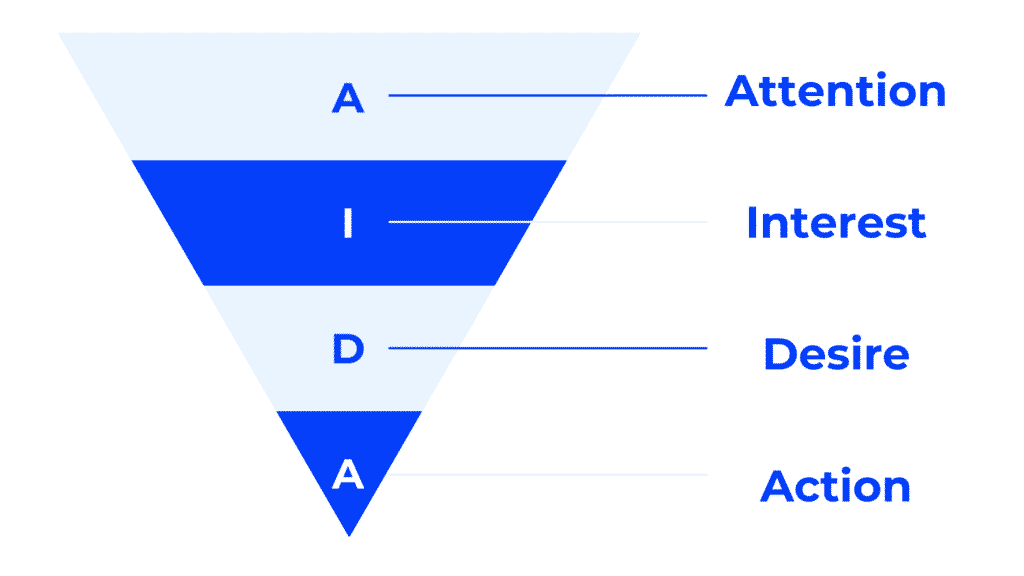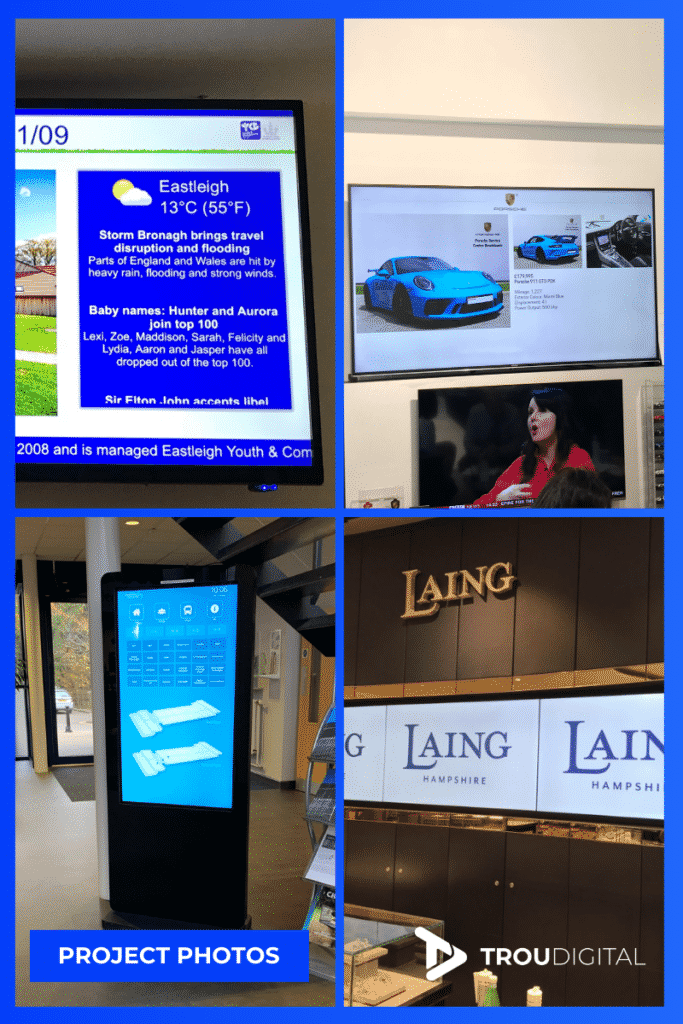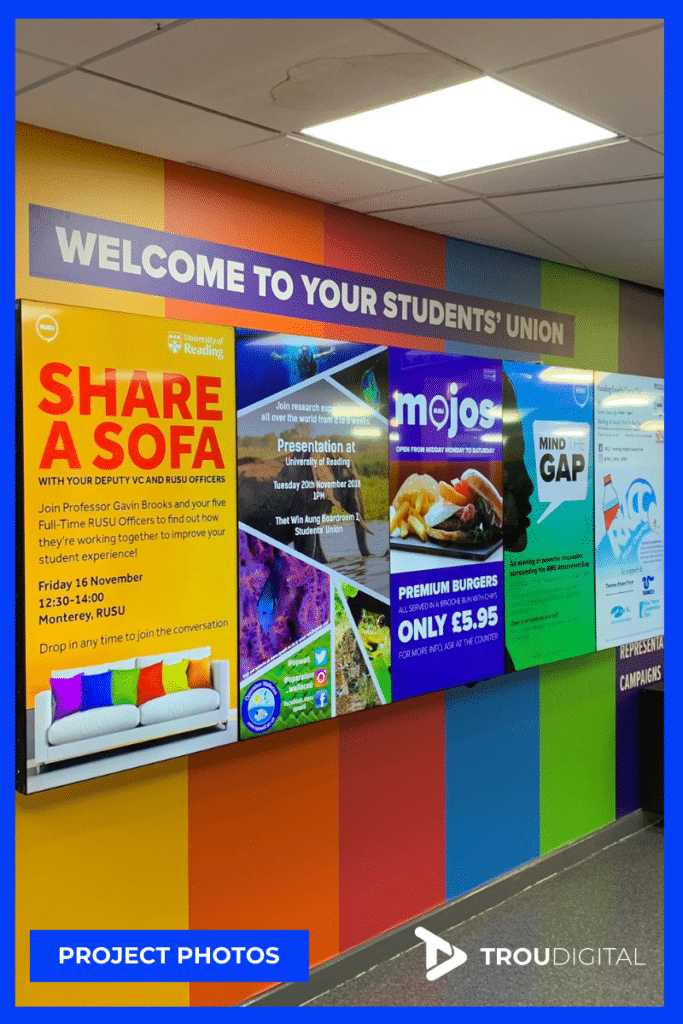Today, we take a look at the role of digital signage within the customer journey. We’ll see how digital signage can affect each stage of the AIDA model and how it can benefit your organisation.
Digital signage is a powerful vehicle for communications and digital messaging across a range of industries. Through screens and software, marketing and communications teams are able to get messages out quickly to those who matter most. Whether it’s to spark interest, gain attention, evoke desire, or encourage action, these teams can get their messages across in seconds.
Digital signage can help speed up the customer journey – reducing the time taken for a potential client to become a raving fan.
Let’s dive into it!
The AIDA Model, customer acquisition journey
The AIDA Theory, by Elias St. Elmo Lewis, is an advertising theory that highlights the different stages within the sales funnel. You can picture the AIDA model as part of the customer journey mapped out (From before a customer even considers a purchase to when they make the all-important purchase).
It’s important to note that the AIDA theory doesn’t map out the entire customer journey. The post-sales cycle isn’t referenced, however, the AIDA model focuses on getting a potential customer interested in a product or service before making a decision.
AIDA stands for:
- Attention – grabbing awareness of the product/service.
- Interest – potential customer becomes interested in finding out more about the product/service.
- Desire – they begin to favour your product/service and want it.
- Action – the forming of a purchase intension – whether that’s ordering something, booking a demo or a grabbing a free trial.
See below for our diagram of the AIDA model.
How could you apply it to your sales and marketing processes?

Getting Attention
Attention is the first part of the customer journey. It’s where potential customers become aware of the product/service. This stage is critical. If your audience doesn’t know about you, your products or services, then how can they possibly make a purchase?
You need to think about where your audience will be and what they want – whether that’s B2B or B2C, online or in-store, and what their pain points would be.
Allan Dib, the author of the ‘1-Page Marketing Plan‘, speaks about focusing on the problem you want your product/service to solve rather than what it does. This makes your marketing message much clearer and makes people desire what you have to offer.
I.e. instead of saying “this software allows you to create 10 designs a minute”, you would say something like “save time on design and spend more time doing X” – assuming the customer’s pain point is they spend too much time designing content.
Once you have this down, it’s time to get your target audience’s attention.
Getting attention with digital signage
An example of where you could see Digital Signage includes supermarket shop windows, estate agents, and beauty salons.
Many use digital signage to show business-critical information to staff (internal communications) or to customers. It is a great opportunity to turn heads.
Content on screens can be far brighter and more animated than other methods. A screen with moving images is far more likely to grab attention than a printed poster.
Placing screens in your shop windows can provide a great opportunity for attracting more foot traffic. Dynamic content that turns heads paired with irresistible offers can be a powerful sales tool.
If you had screens in your literal or metaphorical shop window, display content that features your customer’s pain points. This will make people more likely to stop and look. With a great offer on-screen they’re more likely to come inside. This will lead to more sales. More sales means more turnover. More turnover means more profits. Profit equals happy shareholders. Happy shareholders is money well spent.
Being able to grab attention effectively requires a mix of high-quality content and knowing your audience.
To grab attention effectively, you’ll want to nail down your target market (personas, demographics, psychographics, geography). Then you outline your message to the target market (for instance – what pain points/problems are you solving for them). And you finally cover what media you will use to reach them (whether that’s social media, guest blogs, posters, or digital signage, etc). This helps you to clarify your message to the target market as well as how you will reach them.
Content ideas that grab attention on digital signage
Due to the versatility and variety of digital signage content out there, there are many content types you can utilise to grab attention.
These include:
- Videos
- Animations
- Facts
- Limited time offers
- Countdown timers
- Live feeds
- Social media
- QR codes
- Reactive content (personalised via numberplates or RFIDs)
- Strong branding
- Company messaging
- Questions
- Reviews

Creating Interest with digital signage in the customer journey
Interest is where the potential customers begin to look into your product/service and decide if it’s a good fit for them. They start learning about your product benefits and how it fits with their lifestyle/business.
An example of this, using digital signage, could be promoting what they’re ‘interested’ in. Whether that’s the fact that your food in-store is vegan or high in protein, or you have a special clothing line for maternity, or you’re promoting a certain event or discount. In conclusion, people will see it and think ‘yes, this is for me’.
Ensure your content is easy to read and structured nicely. This will maximise the chances of your messages being seen and read.

Desire with digital signage in the customer journey
Desire is where the consumer develops a favourable disposition towards the product, and they begin to want it.
Having a USP (unique selling point) will work wonders for you when it comes to your products/services being desirable and standing out from the competition – this will make more people go to you.
USPs that will supercharge desire:
- Sharing fresh insight or industry facts about your products and services on your screens.
- Being sustainable/carbon neutral – is very important in this day and age – more people than ever are beginning to care more and more about the ongoing impact of humans on the planet. Pledging to be more sustainable could be the thing that gets you a step up over others. Make sure you look into your suppliers carefully, have fair trade/locally sourced goods, and try your best to do any other initiatives. Companies like Tala have plantable tags on their products which is a massive selling point for them and makes them stand out from competitors. Displaying your sustainabilty conquests on your screens is a great way to help you stand out.
- Support. Customers care about support. If something goes wrong, or isn’t right, they want to know they’ll be looked after. Let them know before they buy that they’re not going to be left out in the dark.
In your content, try and include some USPs and make them known. Maybe highlight your bread is the only vegan bread in a city, your cars charge the fastest, or you’re the only company providing a product in a given field. Think about what’s important to your customers and let this shine through your content.
Action – the final step of the Customer Journey
Action is the final stage of the AIDA theory. At this stage, the customer will be making the decision to pull their wallet out and make a purchase.
But how do you encourage action? You need a call to action (CTA). A CTA provides a customer or user with a next step. Online CTAs are commonly found on buttons that exist on emails or landing pages. The text will read something like ‘book now’, ‘get your free trial’, ‘contact us’, or something similar. The main goal of a CTA is to provide the next step and not leave your customers in the dark.
You’ll find many, many calls to action in the offline world. Signs saying ‘pay here’, a post box saying ‘post here’, a ‘sanitise here’ sign, are all examples of CTAs.
Examples of CTAs on digital signage
- A QR code on screen with text saying ‘scan here’.
- A message telling the audience to visit the website.
- A phone number saying ‘call us on X’.
- Content featuring a ‘buy now’ button.
- Buttons that tell the user to press them to envoke a certain action (use our map, see more, book a meeting etc.).
On your screens, you’ll want to try and include a CTA on your content to try and encourage users to take action. Whether you’re looking to direct, sell, or generate sign-ups and phone calls, this is crucial to generate an action. Providing a strong CTA gives users the next step and shows them where they need to go to act on the messages on screen.
One study found that adding a CTA button to their article templates increased conversions by 83%, and it boosted ecommerce conversions by 22%. Copyblogger found something similar; when their CTAs looked like buttons instead of plain text, they saw a conversion rate increase of 45%.
AdEspresso, by Hootsuite, 11 May 2021
Deliver an out of this world post-sales experience that keeps them coming back
Once your prospect becomes a customer, you’ll need to deliver a world-class experience. This can include regularly keeping in touch with customers, adding value each time you make content. Maybe it’s advice, free resources, or another offer. Consistent contact keeps you top of mind and your customers engaged.
When you have this nailed, you can investigate how to increase customer lifetime value (loyalty programs, upselling, and so on).
Then you can orchestrate and stimulate referrals. This would mean having referral schemes in place so that existing customers would promote to their friends and get rewarded as well as thinking about how you will promote this to them. Maybe your customers get a £10 voucher for each friend they recommend? The power is in your hands.
What now?
Think about each stage of the AIDA theory and what tactics you can use to nail each part.
Whether that’s using bold colours, animations and digital signage to grab the attention of passers-by, promoting a limited-time offer to build a desire to purchase, or put in a call to action like ‘head to our site for a free trial’. The role of digital signage in the customer journey is massive.
If you have any questions about using digital signage in your customer journey, then please head to our contact form or book a free demo.
